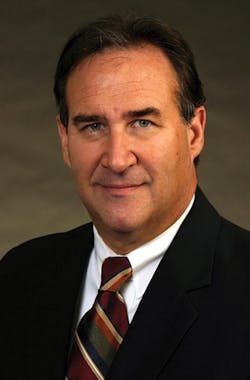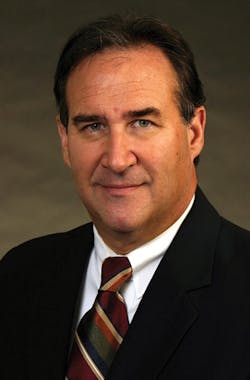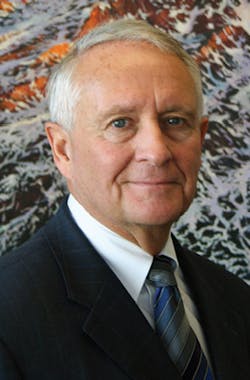The Trump administration is following through on its promise to reform federal regulations enacted during Barack Obama’s presidency that went too far, officials from leading US oil and gas associations told Oil & Gas Journal. But a prolonged partial government shutdown and tariffs or quotas on specialty steel imports could cloud the 2019 Washington Oil and Gas outlook, they warned.
“In the last administration, about 12 federal programs took on state and local responsibilities. That’s changing,” noted Independent Petroleum Association of America Pres. Barry Russell on Jan. 16. “Some policies need to be finalized. Tariffs and quotas affect our industry, and the US-Mexico-Canada Trade Act needs to be ratified.”
American Fuel & Petrochemical Manufacturers Pres. Chet Thompson said on Jan. 11, “So far, I haven’t heard of any major impacts from the shutdown. As a former [US Environmental Protection Agency] employee, I’m sympathetic. The biggest effect could be on getting permits for projects, but it will take some time to determine how great it will be.”
Associations also are preparing for more congressional oversight in 2019 now that the US House of Representatives’ majority has moved to Democrat from Republican control following the 2018 midterm elections. Several groups say educating new members from both parties about oil and gas issues will be more important than ever.
“In the last administration, about 12 federal programs took on state and local responsibilities. That’s changing. Some policies need to be finalized. Tariffs and quotas affect our industry, and the US-Mexico-Canada Trade Act needs to be ratified.”—Independent Petroleum Association of America Pres. Barry Russell
“It doesn’t strike me that most Democrats have energy itself in their crosshairs. They’re certainly interested in global climate change, but I’m not overly concerned about the industry’s becoming a target in-and-of itself,” Natural Gas Supply Association Pres. Dena Wiggins indicated on Jan. 17.
Kathleen Sgamma, president of the Western Energy Alliance in Denver, said on Jan. 14, “Congress didn’t get much done working with a slight Republican majority in the House. It won’t do much with a slight Democratic majority. Consequently, we’re going to focus on working with the administration.”
Energy infrastructure needs
Many also said that improving the nation’s oil and gas transportation systems should not be overlooked in the broader national infrastructure debate.
“It will be important to mention that oil and gas pipelines are financed by private-sector investments. They don’t involve public financing questions that building highways and bridges can raise,” Interstate Natural Gas Association of America Pres. Donald F. Santa observed on Jan. 15.
Association of Oil Pipe Lines Pres. Andrew J. Black said on Jan. 16, “We hope that steel tariffs go away, or the list of countries to which they apply is reduced. Next, we want to make certain that trade negotiations don’t result in quotas for steel which are just as unhelpful, and also create uncertainty.”
“We hope that steel tariffs go away, or the list of countries to which they apply is reduced. Next, we want to make certain that trade negotiations don’t result in quotas for steel, which are just as unhelpful, and create uncertainty.”—Association of Oil Pipe Lines Pres. Andrew J. Black
Most crude and product pipeline operators are not talking much about how quotas and tariffs are hurting them, Black told OGJ. “They don’t want customers going to competitors. But it has to be hurting them,” he said. No pipeline operator will say that a project is not going forward, but some that have been planned are being combined with others because of the uncertain economics, he added.
Getting pipeline routes approved also continues to be difficult in several instances. Wiggins said the US Federal Energy Regulatory Commission is doing a good job as it reviews proposed projects, but opponents often challenge its decisions. Cost overruns for the Equitable and Mountain Valley projects have reached millions of dollars, she pointed out.
“Opponents have a right to express their views, but the energy industry, from the wellhead to the burner tip, needs to do a better job making the case that oil and gas are important parts of the US energy mix and will remain so in the future,” NGSA’s president said.
More attention needs to be paid in the US Northeast, where much of this obstruction harms consumers, Wiggins continued. “What’s going on in New York is particularly egregious. People elect lawmakers to represent their interests, but when the Department of Environmental Conservation used its authority under the Clean Water Act to stop an interstate gas pipeline, it affected consumers in other states,” she said.
Violating cooperative federalism
Santa said, “If these states acted pursuant to state law, that would be one thing. However, they’re acting under the CWA for political purposes. We think they’re violating the concept of cooperative federalism. We hope that other states which are affected, whether as gas producers or consumers, will weigh in.” FERC, in some cases, has ruled against this maneuver because the state agency did not act within the timeframe outlined in the CWA, he added.
INGAA Vice-Pres. for Legislative Affairs Martin E. Edwards noted, “There’s a nexus between the consumer and environmental angle. I think environmental politics are winning out.” Reauthorization of the 1968 Pipeline Safety Act, which historically has been bipartisan, tops the interstate gas pipeline association’s 2019 congressional agenda, Edwards told OGJ. “It will be important to educate policymakers about pipeline infrastructure’s importance,” he said.
“Congress didn’t get much done working with a slight Republican majority in the House. It won’t do much with a slight Democratic majority. Consequently, we’re going to focus on working with the administration.”—Western Energy Alliance Pres. Kathleen Sgamma
Santa said, “The administration did a lot to get reauthorization moving, particularly [the US Pipeline & Hazardous Material Safety Administration’s] pipeline safety advisory committee, which went through a big complex rule and came up with some major changes. This could be the biggest rewrite in years. It’s pretty consequential.”
Santa said he also saw a growing focus on pipeline security in 2018 because of the administration’s emphasis on resilience. Physical and cybersecurity are dynamic areas where the US Departments of Energy and Homeland Security and the Transportation Security Administration are involved, Santa said.
“While there are areas that TSA says can be improved, that’s not to say that pipelines aren’t working to address serious risks,” Santa said. “This is critical infrastructure that provides energy for our economy. We should be sharing threat information and best practices to make certain we’re doing the best possible job.”
The Permian basin’s production growth is a dramatic example of the need for more domestic pipelines, AOPL’s Black said. “When such a big supply is involved, more projects can move ahead. FERC has done a wonderful job of reviewing and authorizing them,” he told OGJ. “Pipelines will catch up once the production grows. It’s how the market works.”
Steel tariffs, quotas
“We expect to see a lot of activity in Congress, but I don’t expect it to turn into legislation,” IPAA Executive Vice-Pres. Lee O. Fuller said. The administration is a different story, with its tariffs and quotas on tubular steel, he added.
The quota agreement it reached with South Korea, where quotas were based on upstream oil and gas demand for specialty products in 2015, 2016, and 2017, is the apparent model, Fuller said. The problem is that demand was not high those years and a 70% quota would hit around 32% of current demand after which tubular goods could not be imported, he noted.
“If these states acted pursuant to state law, that would be one thing. However, they’re acting under the CWA for political purposes. We think they’re violating the concept of cooperative federalism. We hope that other states which are affected, whether as gas producers or consumers, will weigh in.”—Interstate Natural Gas Association of America Pres. Donald F. Santa
“The quota structure threatens US energy dominance. We also would not like to see quotas adopted for imports from Canada and Mexico,” Fuller said. Some pipelines are being built, with scheduled 2019-20 completions, but they all may not be constructed because they are based on using imported steel, which would be subject to quotas, he added. Steel also represents about 10% of the costs in drilling a well, which would be affected if quotas are adopted, he said.
At EPA, a main issue for upstream independents is expected to be proposed methane regulation revisions, Fuller told OGJ. “We’re focused on the treatment of low-production wells,” he said. “When EPA proposed its 2016 regulations, it proposed excluding low-production wells from fugitive emission control requirements. But the exclusion wasn’t there in the final rule.”
In 2017, EPA revised the rule and restored the low-production exclusion “but not in a way we like,” Fuller said. It excluded 15 b/d wells, but not those producing at 20 b/d, he explained. “We think EPA isn’t familiar with low-production well dynamics. We’d like to see it wait on imposing a program until DOE completes its study of low production emissions,” he said.
Finally, EPA’s fugitive emissions requirements lock a producer in for 8 years, during which a state may have developed a new, better technology, according to Fuller. IPAA would like to see such requirements declared equivalent to meet federal New Source Performance Standards, he said.
Studying produced water
EPA also is looking at a possible higher use of produced water, which now is limited under federal rules, IPAA’s Fuller continued. “State water laws, particularly in the West, are complicated and could affect agreements between producers and users of produced water,” he observed.
Upstream independents also are concerned that fossil fuel opponents are trying to turn FERC into a more political entity, while some in the Trump administration would like to see coal given preferential treatment over oil and gas, noted IPAA Senior Vice-Pres. of Regulatory Affairs Susan E. Ginsberg.
PHMSA, meanwhile, needs to finish its reexamination of the 2011 regulations for gathering lines, Ginsberg said. It got a proposal from various interest groups to its Gas Pipeline Advisory Committee, which was scheduled to meet Jan. 8-9 but could not because the Department of Transportation was closed, she said. “We’d like to see it finalized, but it becomes more difficult as the shutdown drags on.”
“What’s going on in New York is particularly egregious. People elect lawmakers to represent their interests, but when the Department of Environmental Conservation used its authority under the Clean Water Act to stop an interstate gas pipeline, it affected consumers in other states.”—Natural Gas Supply Association Pres. Dena Wiggins
WEA’s Sgamma said that the Denver-based association’s members have found the first 2 years under the Trump administration an improvement over the previous 8 years under Obama. Acting administrators at BLM and EPA “cleared out the regulatory overreach which was meant to stifle oil and gas development,” she told OGJ. “The next 2 years will need to include implementing policies and making sure that that we can survive what future administrations do, whether in 2 years or 6 years.”
Daniel T. Naatz, IPAA’s senior vice-president of government relations and political affairs, said, “With all that’s going on, this is an exciting time.” The House Natural Resources Committee’s new chairman, Rep. Raul M. Grijalva (D-Ariz.), can be expected to hold some hearings, but Naatz expects the Trump administration to continue emphasizing the US Bureau of Land Management’s multiple-use mission, he told OGJ. “We’re excited about this because several of our members have production on federally managed land in Wyoming,” Naatz said. “Our goal will be to see BLM streamline, not do away with, regulations.”
Leasing should proceed
Offshore, Naatz said it will be important for oil and gas lease sales to go ahead. “Our members need this. Technology has helped them reduce their footprints onshore and offshore. We’ll talk to anybody because this all creates jobs,” he told OGJ. “Republicans and Democrats support this. We hope to see bills that will help independent producers contribute to the economy.”
National Ocean Industries Association Pres. Randall B. Luthi said that NOIA and its members hope preparations for upcoming offshore oil and gas lease sales continue at the US Bureau of Ocean Energy Management despite much of the rest of the US Department of the Interior’s being shut down. “There also needs to be a new Interior secretary. One would hope that the 5-year Outer Continental Shelf plan is proposed before the nominee’s confirmation hearing so he or she can say it’s already out and comments are being submitted for the record,” he said.
“There also needs to be a new Interior secretary. One would hope that the 5-year Outer Continental Shelf plan is proposed before the nominee’s confirmation hearing so he or she can say it’s already out and comments are being submitted for the record.”—National Ocean Industries Association Pres. Randall B. Luthi
Offshore producers and service companies also would like to see resolution of financial assurance questions raised nearly 2 years ago in a Government Accountability Office report following a sizable US production downturn, Luthi said. He said an Obama administration proposal looked reasonable, but the Trump administration put it on hold and asked that facilities that would be covered be identified, which could present problems.
“We’ve always supported a new rule and heard that it would be proposed,” Luthi said. “The issue remains how to divide financial liability between past and current owners.” He explained that in 2010, what then was called the Bureau of Ocean Energy Management, Regulation, and Enforcement advised offshore leaseholders to catch up on facilities that needed to be decommissioned, which inflated bonding costs.
“We have a chance to take a look at that rule now. The sooner it is proposed, the sooner we can comment,” Luthi said. “We’re also entering the third year of an unpredictable administration, and this might not get done.”
Examining LNG policies
Center for Liquefied Natural Gas (CLNG) Pres. Charlie Riedl said the group will try to get DOE to reform, rather than repeal, export project approval requirements by creating a more predictable timeline. He also would rather see reforms developed legislatively because “any time DOE makes a modification, it could just as easily be undone in the next administration.”
Riedl told OGJ on Jan. 16, “We’re fortunate because LNG generally has bipartisan support. We’d like to see legislation to give PHMSA money to continue hiring qualified inspectors and staying up to date to keep LNG operations safe. Consistency also is essential in safety inspections. Understanding safety technology breakthroughs will be essential.”
“We’d like to see the trade war with China resolved before it becomes a problem for US LNG suppliers. Otherwise, LNG will remain a piece of collateral damage. It was one of the last items on which the Chinese placed a tariff, and it probably would be one of the first to have it removed.”—Center for Liquefied Natural Gas Pres. Charlie Riedl
Riedl said CLNG’s members have been very vocal about telling administration officials problems the trade war with China is creating with a country that is poised to be the world’s largest LNG purchaser by 2020. “We’d like to see them resolved before it becomes a problem for US LNG suppliers,” he said. “Otherwise, LNG will remain a piece of collateral damage. It was one of the last items on which the Chinese placed a tariff, and it probably would be one of the first to have it removed. We’d like to see that.”
AFPM’s Thompson said, “For our petrochemical members, the biggest uncertainty is where the administration’s trade war with China will go in the future. There’s a lot of capacity built in this country which is based on exports. We’d like to see the administration end the trade war with China and Congress ratify the US-Mexico-Canada trade agreement.”
The agreement’s ratification particularly needs to be completed, he told OGJ. “Half our crude imports come from Canada, and a third of our refined product exports go to Canada and Mexico. I believe we supplied 60% of Mexico’s refined products last year,” Thompson said. “Exports are a huge part of US refining, which is the most efficient market in the world. Product exports have set records for the last 3 years.”
Meeting IMO 2020 limits
With Tier 3 regulations reducing sulfur in gasoline complete and being implemented, Thompson said the next big challenge for US refiners will be the International Maritime Organization’s Jan. 1, 2020, implementation of a reduction in marine bunker fuel emissions limits to 0.5%.
“It’s certainly one of the biggest regulations to hit the industry in a long time. The US refining industry invested $100 billion to get ready for it. We’re better situated than the rest of the world, frankly,” he said.
“For our petrochemical members, the biggest uncertainty is where the administration’s trade war with China will go in the future. There’s a lot of capacity built in this country which is based on exports. We’d like to see the administration end the trade war with China and Congress ratify the US-Mexico-Canada trade agreement.”—American Fuel & Petrochemical Manufacturers Pres. Chet Thompson
He also indicated that problems with the federal Renewable Fuel Standard’s volume requirements will need to be addressed in 2019 since corn ethanol groups continue to push for year-round sales of gasoline with 15% ethanol. Acting EPA Administrator Andrew Wheeler has asserted that EPA has the authority to grant such a waiver, but AFPM strongly disagrees, Thompson said.
“EPA historically has insisted it doesn’t have such authority. Now, it has said it wants to get a new regulation by Summer Driving Season, although the government shutdown could keep this from happening. We certainly intend to use all our options to prevent this from happening,” he said.
AFPM, fuel retailers, and automakers meanwhile, support the discussion draft that Reps. John Shimkus (R-Ill.) and Bill Flores (R-Tex.) introduced late in 2018 that establish a 95 Research Octane Number for gasoline in the US.
“Their bill didn’t specify where this higher octane would come from, but the least expensive source would be ethanol,” Thompson said. “This would be a huge move. It’s a reasonable proposal. I hope the House’s flipping doesn’t mean we’ll lose momentum on this idea.”
He said, “The US refining industry is in a good place. It will keep moving ahead. It will keep expanding and promoting our products worldwide. And if folks proposed ideas which would reduce or eliminate that, we’ll be right there to explain why they’re wrong.”
About the Author

Nick Snow
NICK SNOW covered oil and gas in Washington for more than 30 years. He worked in several capacities for The Oil Daily and was founding editor of Petroleum Finance Week before joining OGJ as its Washington correspondent in September 2005 and becoming its full-time Washington editor in October 2007. He retired from OGJ in January 2020.








